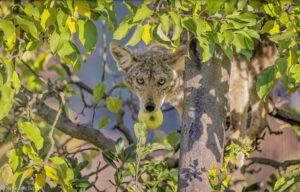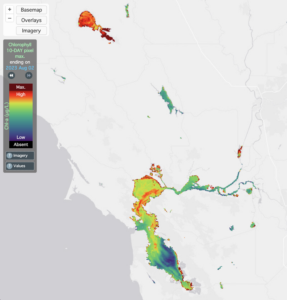One recent sunny morning a young coyote lounged on the fairway of San Francisco’s Lincoln Park Golf Course, unphased by the whizzing golf balls and carts. Over the past decade coyotes have become part of the city’s scenery, including Lands End and the adjacent Lincoln Park Golf Course.
“You mostly see them early in the morning, but sometimes during the day in the middle of the fairway. They don’t move when people play golf,” says Larry, the pro shop clerk.
About five years ago, coyotes turned up at the golf course, part of the gradual march towards urbanization that has taken hold of the normally reclusive Canis latrans. Although seemingly unsuitable habitat, coyotes actually do quite well in cities like San Francisco. The survival rate among urban coyote pups — up to 67 percent — is nearly five times higher than rural ones.
“That’s almost unheard of in a natural environment,” said Stanley Gehrt, associate professor and wildlife biologist who leads the longest-running urban coyote study in the world.
Gehrt’s work centers in Chicago, but he says survival rates among urban coyote pups are probably similar in San Francisco and other cities. In the rural Midwest, pup survival is 15%, with most dying before reaching their second year.
In this second story in the Bay Nature series on urban coyotes we examine why coyotes see cities like San Francisco as ideal habitat — despite all the cars, cement, and whizzing golf balls. In the first story in our series, “Urban coyotes in our midst,” we found out how the Golden Gate Bridge is the highway for coyote migration, and connects distinct populations north and south of the city.
Under protection
Under the protection of the city’s no hunting and no trapping laws, pups thrive and urban coyote populations continue to grow. Pups account for the greatest number of individuals in a population and are also the most vulnerable, hit hardest by hunting and trapping in rural areas. In cities, the leading cause of coyote mortality, for both young and old, is collisions with cars.
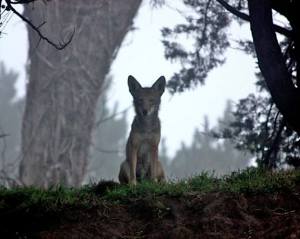
Surprisingly the urban coyote’s diet doesn’t differ much from its country-bumpkin cousin; both prefer to feed on small rodents and fruit, and rarely rely on garbage as food. Though barely any research has been conducted on the ecology of San Francisco’s coyotes, Animal Care and Control has a hunch that the city’s coyotes are feeding on gophers, food left out for feral cats, free-ranging cats, and occasionally trash.
However, cities do offer a more eclectic array of dining options, such as food left out for pets and feral cats. Golden Gate Park, where coyote pups brought in national attention earlier this year, has an extensive albeit ad hoc feral cat feeding program.
Feeding coyotes, even unintentionally, is a major source of conflict.
“Coyotes that are fed in residential neighborhoods can lose their fear of people, and may eventually test humans or pets as possible prey,” says Gehrt.
This why slogans like “a fed coyote is a dead coyote” has been appropriated by cities, agencies, and nonprofits across North America in an attempt to keep urban coyotes wild and foster coexistence. Attacks on people and pets can be lethal, as occurred in Golden Gate Park in 2007 after two coyotes were euthanized after they bit a pair of leashed dogs.
Just being coyotes

Not all conflicts are the fault of coyotes. Sometimes coyotes are just being coyotes and their behavior is deemed appropriate, especially during breeding season (April through June) when they protect their dens from curious explorers like off-leash dogs. Earlier this year, the Presidio Trust dealt with tensions among residents when a coyote took a small dog in the Presidio near its denning site (the unleashed dog antagonized the coyote, chasing it as it was crossing a lawn).
High survival rates and fine dining doesn’t mean that city life is easy living. Coyotes can go to great lengths to avoid city hazards. Most urban coyotes switch to a strictly nocturnal schedule, helping them to avoid people and their dogs and cars. In rural areas, coyotes are usually active during the day or at dawn and dusk.
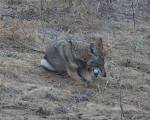
Not all urban coyotes steer clear of people. Like the coyote spotted in Lincoln Park Golf Course, some coyotes get used to having people around. In these cases, known as “habituation,” a person becomes part of the landscape, like a tree or a bush, with neither a positive or negative association.
Habituation, and whether it is good or bad for wildlife, is a relatively new and understudied concept among scientists. But we do know that habituated coyotes can get people nervous.
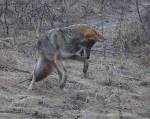 “It’s influenced by personal perception, by an individual’s comfort around the presence of coyotes and by what amount of space makes that person feel scared or excited,” said Camilla Fox, executive director of Project Coyote.
“It’s influenced by personal perception, by an individual’s comfort around the presence of coyotes and by what amount of space makes that person feel scared or excited,” said Camilla Fox, executive director of Project Coyote.
At Lincoln Park Golf Course, where staff say three  coyotes now live, people have pretty much accepted them. Problems mainly arise with dog walking, which is prohibited, says Jim, a grounds keeper.
coyotes now live, people have pretty much accepted them. Problems mainly arise with dog walking, which is prohibited, says Jim, a grounds keeper.
“People try to get their dogs to chase the coyotes,” says Jim. “Otherwise there is no problem. They’re really docile. You can hit a ball 10 feet away from them and they won’t move. They’re really friendly.”
This is the second in a BayNature.org series on urban coyotes. Come back next week for Part 3 to learn about living with urban coyotes.
Courtney Quirin is a Bay Nature editorial intern who has studied urban coyotes extensively in a graduate degree program.


